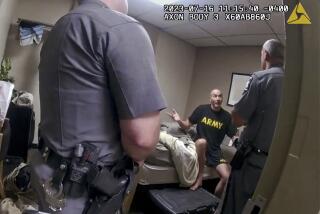This Is Your Brain at Work
- Share via
What does your brain look like while it’s deciding between buying a bicycle or a camera, taking a warm bath or having dinner, eating a slice of chocolate cake or apple pie?
Gray and furrowed, of course, much as usual. Not, however, if you use clever imaging techniques to highlight what parts of its circuitry are buzzing or resting as it ponders its options and deftly makes its choices.
Dr. Dean Shibata, a radiologist at the University of Washington, wanted to know where some of the pondering takes place. He enlisted the help of 11 volunteers, loaded them into a scanner, then asked them to imagine “bicycle or camera”-style decisions while imaging their brains.
Shibata presented the results last week in Chicago, where a passel of radiologists were gathered for a meeting. Pictures abounded at the confab: X-rays of brain aneurysms and colons and lungs and uteruses, even ones of ancient Peruvian mummies (the latter revealing that the people who’d been turned into those mummies had suffered from tuberculosis and arthritis while alive).
Shibata’s pictures--known as functional MRIs--looked like slices of pepperoni with red paint thrown on them in places. The slices: different levels of brain. The red: parts that were especially active while the cake-or-pie-deciding was going on, including regions known to be involved in dealing with emotions.
To Shibata, that implies we’re drawing on emotions when we’re making even fairly trivial decisions (and not just when we’re making angst-laden ones like whether to take that job or do that bungee jump).
Bad feelings from the time we ate cake and got a tummy ache. (Go for the pie!) The time we ate pie, then soon after fell and stubbed our toe. (Go for the cake!)
Though you’d think it would take a million years to get anything decided this way, the brain computes the pros and cons pretty quickly, then spits out an answer.
Decision-making becomes harder when the brain is impaled with a 31/2-foot rod of iron, which is just what happened to one of the most famous men in the history of brain science.
We’re not talking about an eminent neurologist, but a Vermont railroad worker. In 1848, an explosion shot a tamping bar (used to pack gunpowder) right through his head.
The man, Phineas Gage, lived through the experience--never even lost consciousness. But the bolt impaled a part of his brain called the “ventromedial prefrontal cortex”--and he was never the same again.
“This formerly very intact and upstanding worker turned into a kind of drifter, a psychopathic type of guy,” says Dr. Daniel Tranel, professor of neurology at the University of Iowa and one of a team of scientists investigating modern-day brain injuries like these.
People with such lesions in their brains--generally from strokes--go through a Jekyll-Hyde personality change and start making lousy life decisions, just like Gage.
The Iowa scientists have even devised a test that shows how bad such folks are at learning from experiences. Patients pick from two piles of cards, one giving high short-term rewards but steep penalties over time; another giving lower short-term gains but better gains overall.
Normally, people quickly learn to pick from the pile with the best overall gains: One can even detect emotional responses (using polygraph-like tests) as they choose. But those with the brain lesions never learn and never develop physiological responses.
The theory is that this part of the brain is needed to react emotionally to experiences and make sound decisions based on those gut feelings.
The town of Cavendish, Vt.--where Gage had his accident--appears quite proud of its contribution to medical science. It even had a grand celebration a few years back to mark the 150th anniversary. Tranel, family in tow, took a trip to check it out (and also to attend a commemorative “Frontal Lobe Symposium”).
There was a pancake breakfast. A parade. T-shirts and a commemorative postmark. Gage’s real skull was even brought in from the Harvard University museum where it’s housed.
“The whole thing was a little bizarre--it was like being at a fair,” says Tranel. “Except they’re selling memoranda of little skulls with tamping bars in them instead of pencils decorated with the town name.”
If you have an idea for a Booster Shots topic, write or e-mail Rosie Mestel at the Los Angeles Times, 202 W. 1st. St., Los Angeles, CA 90012, rosie.mestel@latimes. com.






